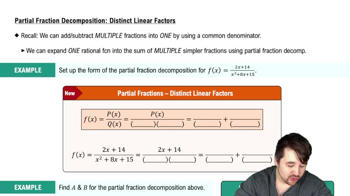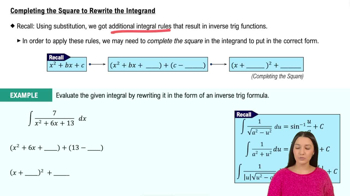Evaluate the integral.
Table of contents
- 0. Functions7h 54m
- Introduction to Functions16m
- Piecewise Functions10m
- Properties of Functions9m
- Common Functions1h 8m
- Transformations5m
- Combining Functions27m
- Exponent rules32m
- Exponential Functions28m
- Logarithmic Functions24m
- Properties of Logarithms36m
- Exponential & Logarithmic Equations35m
- Introduction to Trigonometric Functions38m
- Graphs of Trigonometric Functions44m
- Trigonometric Identities47m
- Inverse Trigonometric Functions48m
- 1. Limits and Continuity2h 2m
- 2. Intro to Derivatives1h 33m
- 3. Techniques of Differentiation3h 18m
- 4. Applications of Derivatives2h 38m
- 5. Graphical Applications of Derivatives6h 2m
- 6. Derivatives of Inverse, Exponential, & Logarithmic Functions2h 37m
- 7. Antiderivatives & Indefinite Integrals1h 26m
- 8. Definite Integrals4h 44m
- 9. Graphical Applications of Integrals2h 27m
- 10. Physics Applications of Integrals 3h 16m
- 11. Integrals of Inverse, Exponential, & Logarithmic Functions2h 34m
- 12. Techniques of Integration7h 41m
- 13. Intro to Differential Equations2h 55m
- 14. Sequences & Series5h 36m
- 15. Power Series2h 19m
- 16. Parametric Equations & Polar Coordinates7h 58m
12. Techniques of Integration
Partial Fractions
Problem 8.6.5
Textbook Question
Choosing an integration strategy Identify a technique of integration for evaluating the following integrals. If necessary, explain how to first simplify the integrand before applying the suggested technique of integration. You do not need to evaluate the integrals.
∫ (5x² + 18x + 20) / [(2x + 3)(x² + 4x + 8)] dx
 Verified step by step guidance
Verified step by step guidance1
Step 1: Analyze the structure of the integrand. The numerator is a polynomial (5x² + 18x + 20), and the denominator is a product of two factors: a linear term (2x + 3) and a quadratic term (x² + 4x + 8). This suggests that partial fraction decomposition may be a suitable technique.
Step 2: Set up the partial fraction decomposition. Express the integrand as a sum of fractions: A/(2x + 3) + (Bx + C)/(x² + 4x + 8), where A, B, and C are constants to be determined.
Step 3: Multiply through by the denominator [(2x + 3)(x² + 4x + 8)] to eliminate the fractions. This will result in an equation involving the numerator (5x² + 18x + 20) and the expanded terms from the partial fraction decomposition.
Step 4: Solve for the constants A, B, and C by equating coefficients of like powers of x on both sides of the equation. This involves algebraic manipulation to match terms.
Step 5: Once the partial fractions are determined, rewrite the integral as the sum of simpler integrals: ∫ A/(2x + 3) dx + ∫ (Bx + C)/(x² + 4x + 8) dx. Each term can then be integrated using appropriate techniques, such as substitution for the linear term and completing the square for the quadratic term.
 Verified video answer for a similar problem:
Verified video answer for a similar problem:This video solution was recommended by our tutors as helpful for the problem above
Video duration:
3mPlay a video:
Was this helpful?
Key Concepts
Here are the essential concepts you must grasp in order to answer the question correctly.
Integration Techniques
Integration techniques are methods used to evaluate integrals, which can include substitution, integration by parts, partial fraction decomposition, and trigonometric substitution. Each technique is suited for different types of integrands, and understanding when to apply each method is crucial for simplifying the integration process.
Recommended video:

Integration by Parts for Definite Integrals
Partial Fraction Decomposition
Partial fraction decomposition is a technique used to break down a rational function into simpler fractions that are easier to integrate. This method is particularly useful when the integrand is a fraction where the degree of the numerator is less than the degree of the denominator, allowing for straightforward integration of each term.
Recommended video:

Partial Fraction Decomposition: Distinct Linear Factors
Simplifying the Integrand
Simplifying the integrand involves rewriting the expression in a form that makes integration easier. This can include factoring polynomials, canceling common terms, or using algebraic manipulation to express the integrand in a more manageable way, which can significantly aid in the selection of an appropriate integration technique.
Recommended video:

Completing the Square to Rewrite the Integrand

 1:07m
1:07mWatch next
Master Partial Fraction Decomposition: Distinct Linear Factors with a bite sized video explanation from Patrick
Start learningRelated Videos
Related Practice
Multiple Choice
76
views
